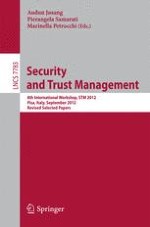This book constitutes the thoroughly refereed post-conference proceedings of the 8th International Workshop on Security and Trust Management, STM 2012, held in Pisa, Italy, in September 2012 - in conjunction with the 17th European Symposium Research in Computer Security (ESORICS 2012). The 20 revised full papers were carefully reviewed and selected from 57 submissions. The papers are organized into topical sections on policy enforcement and monitoring; access control; trust, reputation, and privacy; distributed systems and physical security; authentication and security policies.
